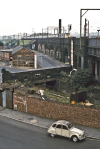brummie-007
proper brummie kid
could be right
It could be a church and the patterned roof might be some kind of engine shed with glass lights in the roof. The buildings in the distance look like houses on higher ground.Any ideas why this roof has such a distinctive pattern? Any builders out there who can advise please ? And could the yellow dot (second copy) be a church ? Holy Trinity at Camp Hill?
View attachment 194547
View attachment 194548
Exactly what I thought. Railway bridge but there is a door/window - as into a hay loftMy first thoughts was a railway bridge but it has a gable end
I keep going back to this lamp which I feel ought to give us a clue. I thought it might be a lamp belonging to the railway. Just had a vague feeling it was one I remember. It had a distinctive 's' bend stem and a sort of 'coolie' hat-type shade. Any thoughts ?Yes, agree probably c1950s, or earliest c1940s. The street lamp behind the girl doesn't look typically Birmingham, although I did wonder if it was by a railway station having that type of lamp. The position of the chimneys to the right suggests to me that this is a road running alongside an embankment. Just a hunchl
At the right hand end there is a dark space exactly as there would be for an entrance to a hay loft.I thought that the structure with the pattern which it has been suggested could well be the side of a railway bridge could be exactly that. I can't see a gable end or a door. Maybe I'm missing something. I can't think why it would have a pattern on but I still think it could be the side of a railway bridge.

I also thought it was a railway bridge but I am now convinced that it is a roof of a factory, the pattern is formed by the skylights in the roof.
We had a similar query a few months ago for an unknown location, that also had a building with a similar pattern of skylights. That location was never pinned down, hopefully we’ll have better luck with this one.i agree john ...i never really thought it was a bridge...definately a building of some sort maybe a barn as we can clearly see a window on the right..
lyn
